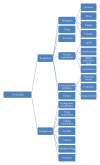Oxidative stress, prooxidants, and antioxidants: the interplay
- PMID: 24587990
- PMCID: PMC3920909
- DOI: 10.1155/2014/761264
Oxidative stress, prooxidants, and antioxidants: the interplay
Abstract
Oxidative stress is a normal phenomenon in the body. Under normal conditions, the physiologically important intracellular levels of reactive oxygen species (ROS) are maintained at low levels by various enzyme systems participating in the in vivo redox homeostasis. Therefore, oxidative stress can also be viewed as an imbalance between the prooxidants and antioxidants in the body. For the last two decades, oxidative stress has been one of the most burning topics among the biological researchers all over the world. Several reasons can be assigned to justify its importance: knowledge about reactive oxygen and nitrogen species production and metabolism; identification of biomarkers for oxidative damage; evidence relating manifestation of chronic and some acute health problems to oxidative stress; identification of various dietary antioxidants present in plant foods as bioactive molecules; and so on. This review discusses the importance of oxidative stress in the body growth and development as well as proteomic and genomic evidences of its relationship with disease development, incidence of malignancies and autoimmune disorders, increased susceptibility to bacterial, viral, and parasitic diseases, and an interplay with prooxidants and antioxidants for maintaining a sound health, which would be helpful in enhancing the knowledge of any biochemist, pathophysiologist, or medical personnel regarding this important issue.
Figures
Similar articles
-
The importance of antioxidants which play the role in cellular response against oxidative/nitrosative stress: current state.Nutr J. 2016 Jul 25;15(1):71. doi: 10.1186/s12937-016-0186-5. Nutr J. 2016. PMID: 27456681 Free PMC article. Review.
-
Free radicals, metals and antioxidants in oxidative stress-induced cancer.Chem Biol Interact. 2006 Mar 10;160(1):1-40. doi: 10.1016/j.cbi.2005.12.009. Epub 2006 Jan 23. Chem Biol Interact. 2006. PMID: 16430879 Review.
-
Genetic and cellular modifiers of oxidative stress: what can we learn from fatty acid oxidation defects?Mol Genet Metab. 2013;110 Suppl:S31-9. doi: 10.1016/j.ymgme.2013.10.007. Epub 2013 Oct 12. Mol Genet Metab. 2013. PMID: 24206932 Review.
-
Redox control of plant growth and development.Plant Sci. 2013 Oct;211:77-91. doi: 10.1016/j.plantsci.2013.07.004. Epub 2013 Jul 18. Plant Sci. 2013. PMID: 23987814 Review.
-
Zinc induces distinct changes in the metabolism of reactive oxygen and nitrogen species (ROS and RNS) in the roots of two Brassica species with different sensitivity to zinc stress.Ann Bot. 2015 Sep;116(4):613-25. doi: 10.1093/aob/mcu246. Epub 2014 Dec 22. Ann Bot. 2015. PMID: 25538112 Free PMC article.
Cited by 234 articles
-
Basic Studies on the Oxidative Stress Markers in Two Types of Horse Breed: Semi-isolated Population of Huculs Is Different from Commercially Used Arabian Horses.Biomed Res Int. 2020 Jul 13;2020:7542384. doi: 10.1155/2020/7542384. eCollection 2020. Biomed Res Int. 2020. PMID: 32733953 Free PMC article.
-
Polyphenolic compounds of amla prevent oxidative stress and fibrosis in the kidney and heart of 2K1C rats.Food Sci Nutr. 2020 May 20;8(7):3578-3589. doi: 10.1002/fsn3.1640. eCollection 2020 Jul. Food Sci Nutr. 2020. PMID: 32724620 Free PMC article.
-
Vasculoprotective effects of Centella asiatica, Justicia gendarussa and Imperata cylindrica decoction via the NOXs-ROS-NF-κB pathway in spontaneously hypertensive rats.J Tradit Complement Med. 2019 Jun 24;10(4):378-388. doi: 10.1016/j.jtcme.2019.06.003. eCollection 2020 Jul. J Tradit Complement Med. 2019. PMID: 32695655 Free PMC article.
-
Assessment of Streptococcus salivarius sp thermophiles Antioxidant Efficiency and its Role in Reducing Paracetamol Hepatotoxicity.Iran J Biotechnol. 2019 Dec 1;17(4):e2061. doi: 10.30498/IJB.2019.91761. eCollection 2019 Dec. Iran J Biotechnol. 2019. PMID: 32671120 Free PMC article.
-
Allosterism of Nicotinic Acetylcholine Receptors: Therapeutic Potential for Neuroinflammation Underlying Brain Trauma and Degenerative Disorders.Int J Mol Sci. 2020 Jul 12;21(14):4918. doi: 10.3390/ijms21144918. Int J Mol Sci. 2020. PMID: 32664647 Free PMC article. Review.
References
-
- Kumar A, Rahal A, Diwedi SK, Gupta MK. Bacterial prevalence and antibiotic resistance profile from bovine mastitis in Mathura, India. Egyptian Journal of Dairy Sciences. 2010;38(1):31–34.
-
- Kumar A, Rahal A, Verma AK. In-Vitro antibacterial activity of hot aqueous extract (HAE) of Ocimum sanctum (Tulsi) leaves. Indian Journal of Veterinary Medicine. 2011;36(2):75–76.
-
- McGinnis JM, Foege WH. Actual causes of death in the United States. Journal of the American Medical Association. 1993;270(18):2207–2212. - PubMed
-
- Mahima, Rahal A, Deb R, et al. Immunomodulatory and therapeutic potentials of herbal, traditional/indeginous and ethnoveterinary medicines. Pakistan Journal of Biological Sciences. 2012;15(16):754–774. - PubMed
-
- Ahmad AH, Rahal A, Tripathi A. Optimising drug potential of plants. Proceedings of the 6th Annual Conference of the Recent Trends in Development of Herbal Drugs: Challenges and Opportunities (ISVPT '06); 2006; Bihar, India. pp. 23–25.
Publication types
MeSH terms
Substances
LinkOut - more resources
-
Full Text Sources
-
Other Literature Sources
-
Medical

